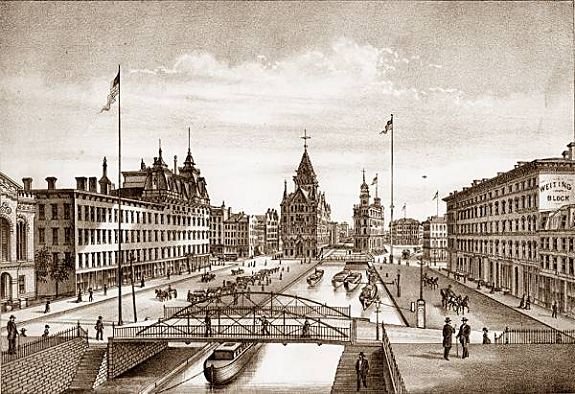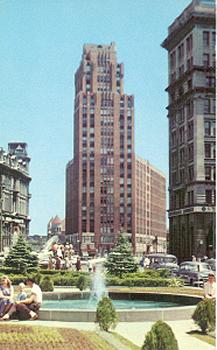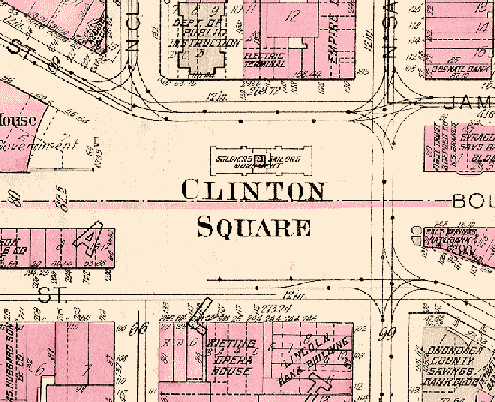|
Clinton Square |
|
|
Engraving, Clinton Square circa 1880 |
|
|
The area known today as Clinton Square was first formed in the early 1800's by the intersection of east/west and north/south highways. Several decades later the Erie and Oswego canals joined this confluence of transportation channels. Syracusans have thought of this spot as the city's focal point for more than 150 years. In the 1940's, with the canal filled in, Clinton Square became primarily a parking lot. Starting in the 1950's, and continuing until only recently, the city focused its attentions away from Clinton Square. Syracuse University Professor of Regional Planning, Peter Andrews, wrote this about the city's plans for the square: "Apparently all thinking has been directed to the development of new public plazas to the east of Salina Street, with a lack of consideration of the important open space and historical value of Clinton Square in the city's plans. It is the most strategically located public square for use by pedestrians in the downtown area, but neither the 1963 City Plan nor the Community Plaza Report indicate any thought of trying to restore Clinton Square to a pedestrian park, or to developing a frame of surrounding buildings that would complete the potential dignity of the space that comes from the existing anchors of the large banks, the post office, and the Third Onondaga County Courthouse. "While the city is to be commended for pushing ahead with the development of the Community Plaza, it seems too bad to let the planning for that one area overbalance the planning of other parts of downtown. If the city were to turn its attention to Clinton Square, it might with far less cost than required for clearance and building of new public spaces, produce a distinctive and well-located public pedestrian area. The reclamation of Clinton Square from its present and planned function of traffic interchange would be an important factor in finding suitable uses of the Third Onondaga County Courthouse." In the 1970's improvements were made to the square. Sections of grass were installed and a modern brick fountain was built. But the new features – particularly the fountain – seemed out of character with the surrounding architecture. In 2001, Clinton Square underwent its largest makeover since the Erie Canal was filled in. Erie Boulevard, running through the Square, was permanently closed to traffic. A large reflecting pool with a shape reminiscent of the original canal outline was installed in the center of the square. The Soldiers and Sailors' Monument was thoroughly refurbished and decorative paving stones were installed throughout the area. With the recent remodel, Clinton Square has once again become a true public square. But how well does it function as a public urban space? Do the buildings that now surround the square provide the services and amenities needed in a public square? How will the new Clinton Square interact with the adjoining Hanover Square? To see more, go to "The Future." |
|


